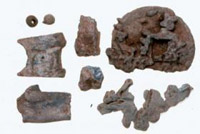 Silver-bearing ore found at the settlement founded by Christopher Columbus's second expedition was not mined in the Americas, new research reveals. The ore that researchers excavated from the settlement, La Isabela, came from Spain, said Alyson Thibodeau, who analyzed the ores. "What appeared to be the earliest evidence of European finds of precious metals in the New World turned out not to be that at all," said David J. Killick. "It's a very different story." The explorers brought the Spanish ore to La Isabela to use for comparison when assaying the new ores they expected to find, the researchers surmise. The expedition's purpose was discovering precious metals.
Silver-bearing ore found at the settlement founded by Christopher Columbus's second expedition was not mined in the Americas, new research reveals. The ore that researchers excavated from the settlement, La Isabela, came from Spain, said Alyson Thibodeau, who analyzed the ores. "What appeared to be the earliest evidence of European finds of precious metals in the New World turned out not to be that at all," said David J. Killick. "It's a very different story." The explorers brought the Spanish ore to La Isabela to use for comparison when assaying the new ores they expected to find, the researchers surmise. The expedition's purpose was discovering precious metals. But by 1497, La Isabela's remaining settlers, having found no gold or silver, were desperate to salvage something of value from the failed settlement. They were reduced to extracting silver from the galena they brought from Spain, the researchers said. "This part of the story of Columbus's failed settlement is one that couldn't be found in the historical documents," said Thibodeau, a geosciences graduate student at The University of Arizona in Tucson. "We could never have figured this out without applying the techniques of physical sciences to the archaeological artifacts."
La Isabela, the first European town in the New World, was established by Columbus's second expedition in 1494 on the northern coast of the present Dominican Republic. The approximately 1500 members of the expedition expected to make their fortunes by finding precious metals but instead found hurricanes, hunger and disease. Columbus was recalled to Spain in 1496, and the few hundred remaining inhabitants abandoned the town in 1498. Archaeologists excavating the site in the late 1980s and early 1990s found about 100 pounds of galena, a silver-bearing lead ore, and more than 200 pounds of metallurgical slag. The ore and slag were associated with a small furnace near the alhóndiga, a building for the storage and protection of royal property. Archaeologist Deagan sent pieces of the material to archaeometallurgist Killick for analysis. The slag turned out to be lead silicate -- the end product of an improvised smelting process, Killick said, adding "Lead silicate is good for nothing." [Note: To read the full article, click here.]